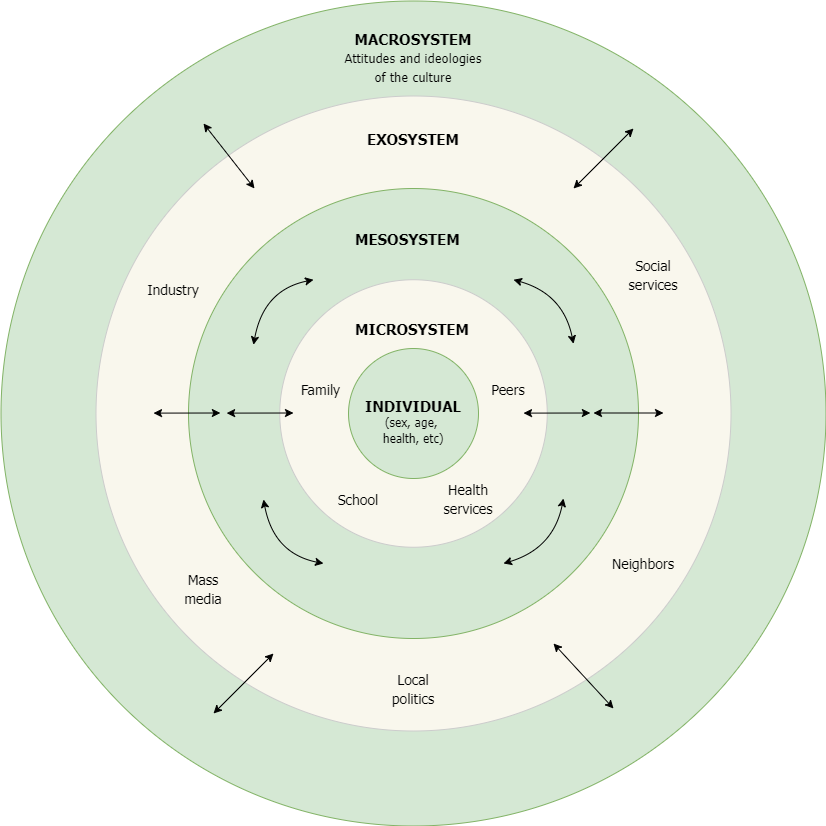Activity 2.3 | Visual Intersectionality Mapping
| Site: | RRU Open Educational Resources |
| Cours: | Relational Leadership in Early Childcare and Education |
| Livre: | Activity 2.3 | Visual Intersectionality Mapping |
| Imprimé par: | Visiteur anonyme |
| Date: | mercredi 3 décembre 2025, 21:16 |
Visual Intersectionality Mapping
In this final activity of Module Two, you will craft a personal visual representation that illustrates the diverse influences and Intersectionalities connecting you to others, both human and other-than-human.
This activity draws inspiration from Bronfenbrenner’s Ecological Systems Model and the Holistic Learning Models from First Nations Pedagogy, which serve as guiding examples.
This exercise will help you explore and recognize the complex relationships you are already always connected to, supporting your growth toward relational leadership.
References
Currie, S., & Kaminski, J. (n.d.). First Nations pedagogy online. First Nations Pedagogy. https://firstnationspedagogy.ca/
Sprouts. (2021, December). Bronfenbrenner's ecological systems: 5 forces impacting our lives [Video]. YouTube. https://www.youtube.com/watch?v=g6pUQ4EDHeQ&t=1s
Bronfenbrenner: Ecological Systems Model
Brofenbrenner's Ecological Systems Model explains how a child's inherent qualities and environment influence how they will grow and develop.

Note. Brofenbrenner’s ecological theory emphasizes the influence of microsystems, mesosystems, exosystems, and macrosystems on an individual. The chronosystem, or the historical context and timeframe, is not pictured, which provides the context for all the other systems. The chronosystem includes environmental events, major life transitions, and historical events. (Image Source: Abbeyelder on Wikimedia Commons, CC BY SA)
Reference
Abbeyelder. (2022). Bronfenbrenner's Ecological Theory of Development [Diagram]. Wikimedia Commons. https://commons.wikimedia.org/wiki/File:Bronfenbrenner%27s_Ecological_Theory_of_Development.png
Three holistic lifelong learning models
Now, interconnectedness and intersectionality should be considered through the lens of the three holistic lifelong learning models. Pay attention to the similarities and differences among the models and consider how each represents the concept of interconnection. Access each of the models through the links provided to explore their visuals and characteristics:
These three models, developed by the Canadian Council on Learning, illustrate how interconnectedness is integral to learning.
The First Nations model, for example, uses the imagery of a deeply rooted tree to represent the factors that contribute to holistic lifelong learning. Each part of the tree symbolizes a specific influence:
- The roots represent the sources and domains of knowledge, including self, people, the natural world, languages, and traditions.
- The trunk reflects the individual’s learning journey, encompassing stages such as early learning, formal education, workplace learning, adult learning, and intergenerational learning.
- The branches signify individual and collective well-being, divided into social, spiritual and cultural, political, and economic domains.
The model emphasizes the balance of body, mind, heart, and spirit, highlighting how individual well-being contributes to the community's collective well-being.
As you engage with these models, consider how they illustrate interconnected relationships and lifelong learning and reflect on how they resonate with your own experiences and understanding.
ReferencesCanadian Council on Learning. (2007). First Nations holistic lifelong learning model. http://firstnationspedagogy.ca/CCL_Learning_Model_FN.pdf
Canadian Council on Learning. (2007). Inuit holistic lifelong learning model. https://firstnationspedagogy.ca/CCL_Inuit_Holistic_Learning_Model_EN.pdf
Canadian Council on Learning. (2007). Métis holistic lifelong learning model. https://firstnationspedagogy.com/CCL_Learning_Model_MET.pdf
Personal Visual Representation
Using the visuals from Bronfenbrenner’s Ecological Systems Model and the three Holistic Learning Models from First Nations Pedagogy as guides and inspiration, create your visual representation/mapping of the multiple influences and intersectionalities which interconnect you to others, human and other than human. This visualization exercise will help you recognize the multitude of relations you are already and always connected to.
You might use a mix of illustrations/drawings and written notes to represent your connections or you might choose to paint, sculpt or another visual medium to express your connections and discoveries.Expand each step to take you through the instructions for engaging in this activity:
Impact of Relational Complexities
The visual representation of the intersectionalities and interconnections you have created in this activity will also support you as you move into Module Three: Culture of Centre, where you will continue cultivating dispositions and commitments that make your relational leadership style and practices visible.
As you have learned, the components and systems that create an ‘individual’ are vast. These aspects of life are personal, far-reaching, and interconnected and come together (directly and indirectly) to shape the decisions and inactions we make, the ways we co-create knowledge, how we engage with and influence the world, and how the world engages with and influences us.
Understanding these relational complexities (i.e., how global affects local and local affects global) empowers leaders to observe, interrelate, and respond holistically to children, colleagues, families, and broader communities, both human and other than human.